Research Archive
For more recent NASFAA research highlights, place visit our Original Research - Highlighted Projects page.
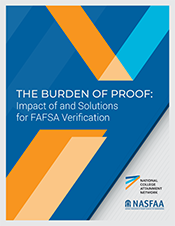 Reducing the Burden of Proof: FAFSA Verification and Improving Access to Federal Financial Aid
Reducing the Burden of Proof: FAFSA Verification and Improving Access to Federal Financial Aid
NASFAA and the National College Attainment Network (NCAN) joined together to survey financial aid administrators and college access and success advisers on the impact of verification on their students and their work within the landscape of verification relief and scrutiny. The resulting paper offers recommendations to decrease the burden verification places on students and financial aid administrators alike.
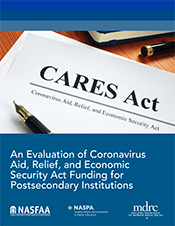 An Evaluation of Coronavirus Aid, Relief, and Economic Security Act Funding for Postsecondary Institutions
An Evaluation of Coronavirus Aid, Relief, and Economic Security Act Funding for Postsecondary Institutions
NASFAA, in collaboration with NASPA—Student Affairs Administrators in Higher Education and MDRC, published a report that sheds light on what worked well and what didn't for postsecondary students and institutions in the rollout and implementation of the CARES Act's Higher Education Emergency Relief Fund (HEERF).
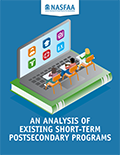 An Analysis of Existing Short-Term Postsecondary Programs
An Analysis of Existing Short-Term Postsecondary Programs
NASFAA, in partnership with Advance CTE and the Association of Career & Technical Education, examined the current national landscape of short-term postsecondary programs to learn more about what they offer, who they serve, and how their graduates fare in the workforce. Read the full report to learn about the challenges institutions face in enrolling students and the challenges students face paying for these programs, and the proposals to extend Title IV student aid like Pell Grants to short-term programs.
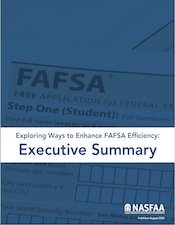 Exploring Ways to Enhance FAFSA Efficiency Paper Series
Exploring Ways to Enhance FAFSA Efficiency Paper Series
NASFAA released a series of 10 papers that provide policy recommendations to help streamline the FAFSA, the culmination of a year-long project in which NASFAA, with funding from the Bill & Melinda Gates Foundation, enlisted and joined subject-matter experts in assessing the current validity of previous work done on FAFSA efficiency and exploring new simplification concepts. Read the papers, as well as the 13 recommendations NASFAA felt would resonate most with its membership and included in its executive summary as official FAFSA simplification recommendations for Congress.
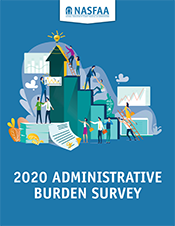 2020 Administrative Burden Survey Results
2020 Administrative Burden Survey Results
NASFAA released the results from the 2020 NASFAA Administrative Burden Survey and found nearly half of respondents faced a moderate shortage of resources that impact their level of services during peak processing periods. This proportion remains virtually unchanged from the 2015 survey. Read the full report, and review the results of studies conducted in 2010 and 2015.
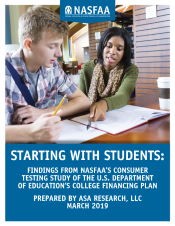 Starting with Students: Findings from NASFAA's Consumer Testing Study of the U.S. Department of Education's College Financing Plan
Starting with Students: Findings from NASFAA's Consumer Testing Study of the U.S. Department of Education's College Financing Plan
In January 2019, the U.S. Department of Education (ED) released the newly updated College Financing Plan (CFP) (formerly the Financial Aid Shopping Sheet). The College Financing Plan is available for voluntary use in 2019-20 and will include additional data elements, a new responsive design, and the ability to customize the colors of the College Financing Plan to match those of your institution.
As part of this update, ED solicited comments and suggestions on the College Financing Plan. To inform our comments NASFAA conducted consumer testing by an outside consulting firm, ASA Research, LLC and conducted a membership survey. Read more>>
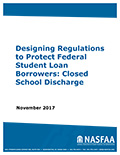 Designing Regulations to Protect Federal Student Loan Borrowers: Closed School Discharge
Designing Regulations to Protect Federal Student Loan Borrowers: Closed School Discharge
The Department of Education has provided some guidance for students displaced by sudden college closures, but a large gap in financial aid knowledge remains for this population. In its new paper, "Designing Regulations to Protect Federal Student Loan Borrowers: Closed School Discharge," NASFAA examines existing and proposed provisions for closed school discharge from the perspectives of equity and efficiency, and provides seven recommendations that underscore the importance of policies that balance the interests of students, institutions, and taxpayers in the event of school closings.
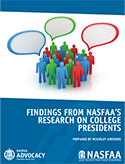 Findings from NASFAA's Research on College Presidents
Findings from NASFAA's Research on College Presidents
NASFAA retained McKinley Advisors to conduct research on college presidents' perceptions of their financial aid offices, administrators, and the profession at large. Overall results showed college presidents were satisfied with their financial aid administrator's ability to perform their job functions and were interested in receiving additional information on how to improve the relationship between and the function of their financial aid departments. Our report "Findings from NASFAA's Research on College Presidents" further details the findings from this study, as well as recommendations for next steps.
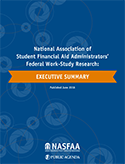 NASFAA Research on Federal Work-Study
NASFAA Research on Federal Work-Study
In Winter 2015, NASFAA was awarded a grant by the Bill & Melinda Gates Foundation to conduct a study of the components needed to efficiently and effectively administer FWS and ways in which schools can strengthen their FWS programs to yield greater persistence and completion among students while staying within federal parameters. The goal of this research was to determine what components would create a framework for understanding, evaluating, and improving FWS that program administrators could use on their campuses. Read more >>
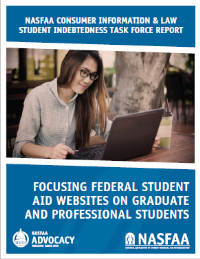 Focusing Federal Student Aid Websites On Graduate And Professional Students
Focusing Federal Student Aid Websites On Graduate And Professional Students
In our report "Focusing Federal Student Aid Websites On Graduate And Professional Students" NASFAA's Consumer Information and Law Student Indebtedness (CILSI) Task Force set out to make recommendations for the StudentAid.gov and StudentLoans.gov websites that would expand their focus to include the needs of G/P students and allow for greater transparency related to G/P program costs and borrowing. With websites tailored to their distinctive needs, G/P students will be better-informed consumers with clearer pictures of their options, leading to institutional choices that are good matches for their long-term financial and educational goals. Read more >>



